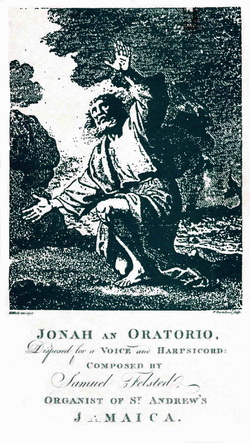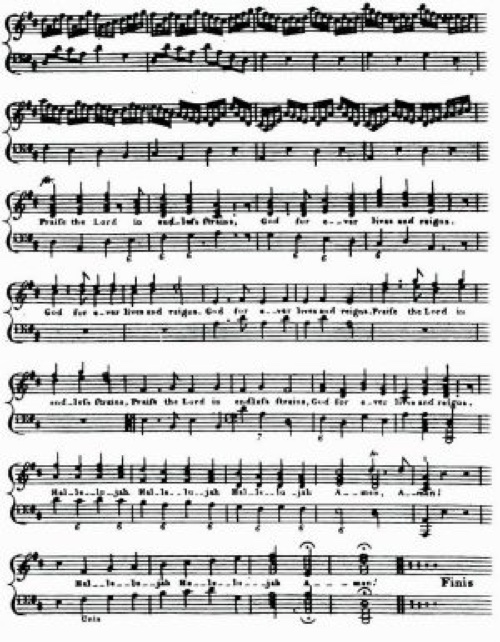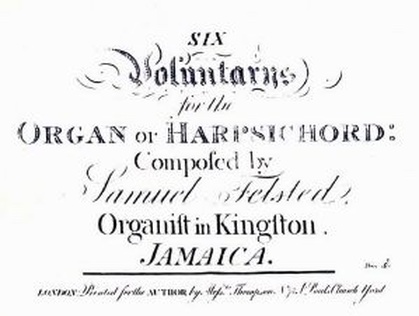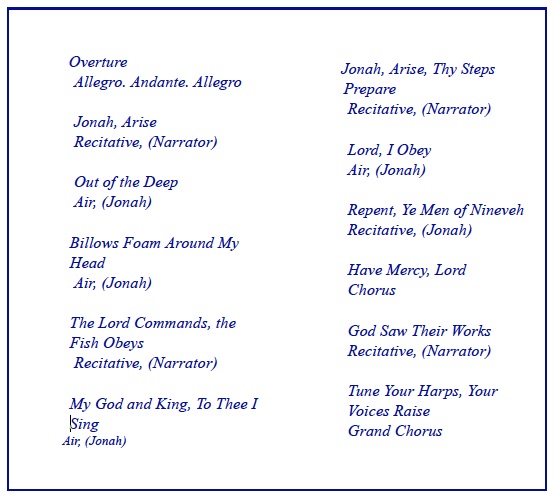Samuel Felsted’s parents, who were originally from England, had married in Philadelphia in 1741. They soon left Pennsylvania and came to live in Jamaica. The older Felsted was in the iron trade, but played the organ and shared the musical interests of the rest of the family. Samuel was born in 1743 and presumably received a good education which provided the foundation of his adult interests in botany, art, poetry and music; he was also described as an ‘inventor’, and an 8 page manuscript records the ‘Plan and Description of a horizontal wheel, invented by Samuel Felsted, 1798’.
He was possibly taught to play the organ by Samuel Patch a Kingston organist and John Raymond who was the organist in Port Royal. He became the organist at the St. Andrew Parish Church probably in his twenties, and held the post until 1783. He then held the same post at the Kingston Parish Church after the death of the previous organist, who may well have been Samuel Patch. Felsted himself died in 1802, and nothing further seems to be recorded of his personal life or career.
|
Felsted’s significance lies in the work he composed around 1773-4 while he was organist at the St. Andrew Parish Church. His oratorio – JONAH – was the first oratorio written in the Americas, and its re-discovery created a great deal of interest in the music world. Dr. Howard F. Smither, the world’s premier authority on the oratorio, has documented the unique position of Felsted’s JONAH in his authoritative work, A History of the Oratorio, (1987).
It was a matter of some surprise that the first oratorio written in the Americas was produced by a hitherto unknown Jamaican composer in an island now known primarily for the music of Bob Marley. However, the work points to a Jamaicathat then featured much more prominently on the world scene as the most valuable of Britain’s colonies and as able to support a level of musical and theatrical activity that could attract the interest of metropolitan performers.
|
|
~~~~~~ Oratorio JONAH . . . . . . Samuel Felsted~~~~~
The background to Samuel Felsted's career
In the programme notes for the 1990 performance of Jonah, Valerie Facey described the Jamaican cultural scene in the later 18th century:
|
‘Jamaica has a rich and varied historical heritage influenced by the many ethnic groups which have graced her shores and shared their distinctive style of artistic and social expression. From the time of the aboriginal Arawak Indians to the arrival of Columbus in 1492 followed by 161 years of Spanish influence and finally the conquest by the British in 1655, an amazing groundwork was laid.
Within a remarkably short period Jamaica became a colony of importance and wealth. Accompanying both the voluntary and involuntary immigrants, the indigenous cultures of Europe and Africa came to the now flourishing and fashionable island where they melded and blossomed into a unique culture all its own. The first ‘Publick Theatre’ is documented in 1682 and horseracing in 1687. Exquisite tortoiseshell objets d’art were being made while gold and silversmiths were crafting Jamaican hall-marked designs in Spanish Town and Port Royal prior to the great earthquake of 1692. In 1688, Sir Hans Sloane was writing his definitive, illustrated natural history of Jamaica. Printing was instituted in 1718 and the many news-sheets and periodicals were advertising a plethora of theatrical presentations, musical happenings and dance opportunities soon after that time. Repertory companies from London and New York were visiting Kingston and Spanish Town by the 1750’s. Grandiose monuments and paintings by visiting artists of repute were being commissioned in addition to exotic wood furniture and fitments. Architectural competitions abounded so that dignitaries could vie for the finest Jamaican/Georgian homes. The latter half of the 18th century could be referred to as the ‘Jamaican Renaissance’ and it was in this climate of learning, science, aesthetic values and ‘elitist’ high-living that Samuel Felsted grew up in Jamaica.’ Errol Hill in The Jamaican Stage, 1655-1900 quotes John Stewart, writing in 1808, as saying that there had been no theatrical performances for about 25 years, but that,‘In Kingston, there are occasionally tolerable concerts, the principal performers in which are French emigrants from St. Domingo.’ The French refugees, and presumably their Black and Coloured slaves, had to use their performing skills to earn a living. In view of the high level of musical performances in St. Domingue before the Revolution, one may well think that the refugees from that colony were somewhat less than impressed by the ‘Jamaican Renaissance’. |
The following quotation gives some idea of the music scene in colonial St. Domingue in the later 18th century:
|
‘The Music of Colonial South America’ by Robert Stevenson, Professor of Music, UCLA.
in The Cambridge History of Latin America, Volume II: Colonial Latin America, edited by Leslie Bethell, C.U.P. 1984 pages 795-6 The foremost mulatto composer born in the Caribbean during the eighteenth century was Joseph Boulogne, Chevalier de Saint-Georges (b.Guadeloupe, 1739; d. Paris, 1799), who studied music in Saint-Domingue with the black violinist Joseph Platon before emigrating to Paris in 1752. In Paris he built up a reputation comparable with that of Gossec (1734 -1829). Beginning in 1775 he published eleven symphonies concertantes, three symphonies, ten violin concertos, fourteen string quartets, twelve sonatas for piano and violin and numerous smaller pieces. His operas included the three-act Ernestine (Paris, Comédie-Italienne, 19 July 1777), La chasse (12 October 1778) and a two-act ‘comédie melée de ballets’, L’Amant anonyme (8 March 1780). Joseph [Platon] played an unspecified Saint-Georges violin concerto at Port-au-Prince on 25 April 1780.
The brilliance of concert and operatic life at Cap-Français, Saint-Marc, Léogane, Cayes, Jérémie, Petit-Goave, Jacmel, and especially Port-au-Prince during the 27 years that can be documented from the Gazette de St.-Domingue, Avis Divers et Petites Affiches Américaines, and other later newspapers covering 1764 to 1791, rivalled or exceeded contemporary musical offerings in the Spanish viceroyalties. Apart from 23 operas by Grétry, six by Philidor, and lesser numbers of works for the lyric stage by Gluck, Dalayrac, Monsigny, Rousseau and Pergolesi, at least three operas by locally based composers were produced: Dufresne’s Laurette (28 October 1773), Bissery’s Le sourd dupé (21 June 1777) and Bouquet disputé (18 June 1783). Dufresne composed also a grande sympbonie concertante a deux orchestres et a echo (25 August 1778) and Bissery a concerto sur forte-piano (22 February 1777). Petit at Port-au-Prince wrote two concertos (8July 1783, 13 June 1783), Fontaine composed ‘ariettes’ and ‘choeurs’ for L’Amant Loup-Garou ou Monsieur Rodomont (16 November 1779). Rivière, a black composer, wrote symphonies concertantes performed at Cayes (iz October 1785), and also ‘ariettes a grand orchestre’, serenades champêtres and pot-pourris for ‘grand orchestre’ (4 March, 23 November 1786; 18 January 1787). Maulan tried his hand at local colour compositions (24 January i1788; 11 March 1790). The first black violinists in the Cap-Français theatre orchestra were three pupils of Tasset aged fifteen, sixteen and seventeen in 1764 and 1765. Rivière played a solo in the Port-au-Prince production of Grétry’ s Le Tableau parlant on 28 December 1779, and on 31 December 1781 the mandoline in a concerto for mandoline and guitar. Julien, another black violinist, played violin solos in a Davaux symphonie concertante (25 April 1780). Two mulatto sisters, Minette and Lise, sang in numerous concerts and operas of the 1780s, Grétry accounting for at least five of their operas: Sylvain, Zémire et Azor, Aucassin et Nicolette, L’Amant jaloux and La caravane du Caire. |
ABOUT THURSTON DOX
The story of the research conducted by Dr. Thurston Dox into the history of the oratorio JONAH and the life and work of the composer Samuel Felsted is an interesting and fascinating story in its own right. After the re-discovery in the 1970’s of Samuel Felsted’s oratorio JONAH and the Six Organ Voluntaries by Sister Mary Dominic Ray, Founder of the American Music Research Center at Dominican College in Boulder, Colorado, and in conjunction with his own research in the field of American oratorios and cantatas, Dr. Dox embarked on what has since become an all absorbing life’s work and a vibrant association with the Island of Jamaica.
From the British Library, which has held a copy of the original 1775 printed score in repository for over 200 years, he was directed in 1979 to Mr. Kenneth Ingram, bibliographer and former librarian of the University of the West Indies. In turn, Mr. Ingram directed Dr. Dox to the National Library of Jamaica where a close relationship was established through correspondence, telephone calls and many personal visits over the next several years.
Further invaluable information was obtained from the Jamaica Archives but not without exhausting hours of his personal scrutiny of myriad documents. Dr. Dox’s indomitable enthusiasm joined with his painstaking research into primary source material and the method with which he sifted and analysed each new item of information became legend with the staff at both the Jamaica Archives and the National Library of Jamaica. They were able to share first hand the excitement of a new discovery and the reward which can be achieved as a result of determination and hard work.
Dr. Thurston J. Dox is a lecturer at Hartwick College, Oneonta, New York. In 1988, the American Music Research Center awarded Dr. Dox a substantial grant which permitted him to undertake further research into the life of Samuel Felsted. In April 1990, he delivered a paper on Felsted at the conference of the prestigious Sonneck Society for American Music. This paper is soon to be published and Dr. Dox’s ongoing work is with a view to a future biography of Samuel Felsted. It is a special privilege to have the presence of Dr. Thurston Dox and Mrs. Dox at this historic
performance of Felsted’s JONAH.
(from the programme of the 1990 performance of JONAH in 1990 in Jamaica.)
The story of the research conducted by Dr. Thurston Dox into the history of the oratorio JONAH and the life and work of the composer Samuel Felsted is an interesting and fascinating story in its own right. After the re-discovery in the 1970’s of Samuel Felsted’s oratorio JONAH and the Six Organ Voluntaries by Sister Mary Dominic Ray, Founder of the American Music Research Center at Dominican College in Boulder, Colorado, and in conjunction with his own research in the field of American oratorios and cantatas, Dr. Dox embarked on what has since become an all absorbing life’s work and a vibrant association with the Island of Jamaica.
From the British Library, which has held a copy of the original 1775 printed score in repository for over 200 years, he was directed in 1979 to Mr. Kenneth Ingram, bibliographer and former librarian of the University of the West Indies. In turn, Mr. Ingram directed Dr. Dox to the National Library of Jamaica where a close relationship was established through correspondence, telephone calls and many personal visits over the next several years.
Further invaluable information was obtained from the Jamaica Archives but not without exhausting hours of his personal scrutiny of myriad documents. Dr. Dox’s indomitable enthusiasm joined with his painstaking research into primary source material and the method with which he sifted and analysed each new item of information became legend with the staff at both the Jamaica Archives and the National Library of Jamaica. They were able to share first hand the excitement of a new discovery and the reward which can be achieved as a result of determination and hard work.
Dr. Thurston J. Dox is a lecturer at Hartwick College, Oneonta, New York. In 1988, the American Music Research Center awarded Dr. Dox a substantial grant which permitted him to undertake further research into the life of Samuel Felsted. In April 1990, he delivered a paper on Felsted at the conference of the prestigious Sonneck Society for American Music. This paper is soon to be published and Dr. Dox’s ongoing work is with a view to a future biography of Samuel Felsted. It is a special privilege to have the presence of Dr. Thurston Dox and Mrs. Dox at this historic
performance of Felsted’s JONAH.
(from the programme of the 1990 performance of JONAH in 1990 in Jamaica.)
[written a decade ago]





